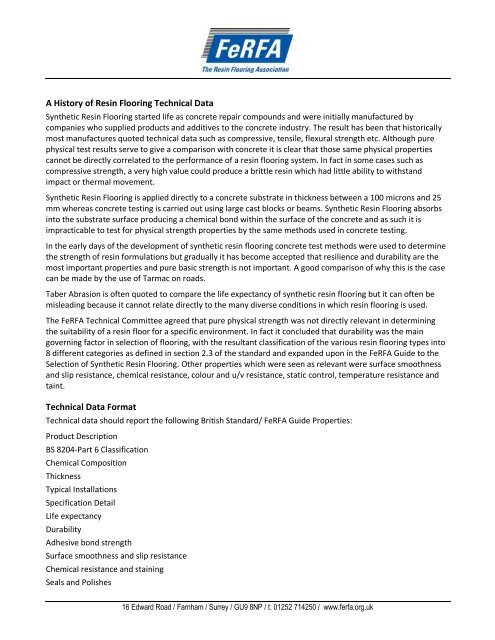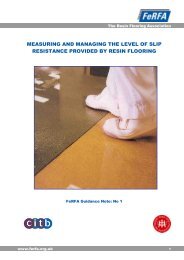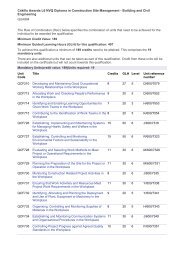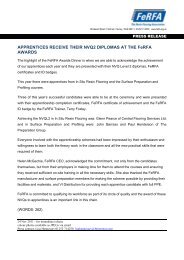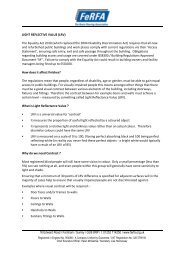Explanatory note to Resin Flooring Technical Data in ... - FeRFA
Explanatory note to Resin Flooring Technical Data in ... - FeRFA
Explanatory note to Resin Flooring Technical Data in ... - FeRFA
You also want an ePaper? Increase the reach of your titles
YUMPU automatically turns print PDFs into web optimized ePapers that Google loves.
A His<strong>to</strong>ry of <strong>Res<strong>in</strong></strong> <strong>Floor<strong>in</strong>g</strong> <strong>Technical</strong> <strong>Data</strong><br />
Synthetic <strong>Res<strong>in</strong></strong> <strong>Floor<strong>in</strong>g</strong> started life as concrete repair compounds and were <strong>in</strong>itially manufactured by<br />
companies who supplied products and additives <strong>to</strong> the concrete <strong>in</strong>dustry. The result has been that his<strong>to</strong>rically<br />
most manufactures quoted technical data such as compressive, tensile, flexural strength etc. Although pure<br />
physical test results serve <strong>to</strong> give a comparison with concrete it is clear that those same physical properties<br />
cannot be directly correlated <strong>to</strong> the performance of a res<strong>in</strong> floor<strong>in</strong>g system. In fact <strong>in</strong> some cases such as<br />
compressive strength, a very high value could produce a brittle res<strong>in</strong> which had little ability <strong>to</strong> withstand<br />
impact or thermal movement.<br />
Synthetic <strong>Res<strong>in</strong></strong> <strong>Floor<strong>in</strong>g</strong> is applied directly <strong>to</strong> a concrete substrate <strong>in</strong> thickness between a 100 microns and 25<br />
mm whereas concrete test<strong>in</strong>g is carried out us<strong>in</strong>g large cast blocks or beams. Synthetic <strong>Res<strong>in</strong></strong> <strong>Floor<strong>in</strong>g</strong> absorbs<br />
<strong>in</strong><strong>to</strong> the substrate surface produc<strong>in</strong>g a chemical bond with<strong>in</strong> the surface of the concrete and as such it is<br />
impracticable <strong>to</strong> test for physical strength properties by the same methods used <strong>in</strong> concrete test<strong>in</strong>g.<br />
In the early days of the development of synthetic res<strong>in</strong> floor<strong>in</strong>g concrete test methods were used <strong>to</strong> determ<strong>in</strong>e<br />
the strength of res<strong>in</strong> formulations but gradually it has become accepted that resilience and durability are the<br />
most important properties and pure basic strength is not important. A good comparison of why this is the case<br />
can be made by the use of Tarmac on roads.<br />
Taber Abrasion is often quoted <strong>to</strong> compare the life expectancy of synthetic res<strong>in</strong> floor<strong>in</strong>g but it can often be<br />
mislead<strong>in</strong>g because it cannot relate directly <strong>to</strong> the many diverse conditions <strong>in</strong> which res<strong>in</strong> floor<strong>in</strong>g is used.<br />
The <strong>FeRFA</strong> <strong>Technical</strong> Committee agreed that pure physical strength was not directly relevant <strong>in</strong> determ<strong>in</strong><strong>in</strong>g<br />
the suitability of a res<strong>in</strong> floor for a specific environment. In fact it concluded that durability was the ma<strong>in</strong><br />
govern<strong>in</strong>g fac<strong>to</strong>r <strong>in</strong> selection of floor<strong>in</strong>g, with the resultant classification of the various res<strong>in</strong> floor<strong>in</strong>g types <strong>in</strong><strong>to</strong><br />
8 different categories as def<strong>in</strong>ed <strong>in</strong> section 2.3 of the standard and expanded upon <strong>in</strong> the <strong>FeRFA</strong> Guide <strong>to</strong> the<br />
Selection of Synthetic <strong>Res<strong>in</strong></strong> <strong>Floor<strong>in</strong>g</strong>. Other properties which were seen as relevant were surface smoothness<br />
and slip resistance, chemical resistance, colour and u/v resistance, static control, temperature resistance and<br />
ta<strong>in</strong>t.<br />
<strong>Technical</strong> <strong>Data</strong> Format<br />
<strong>Technical</strong> data should report the follow<strong>in</strong>g British Standard/ <strong>FeRFA</strong> Guide Properties:<br />
Product Description<br />
BS 8204-Part 6 Classification<br />
Chemical Composition<br />
Thickness<br />
Typical Installations<br />
Specification Detail<br />
Life expectancy<br />
Durability<br />
Adhesive bond strength<br />
Surface smoothness and slip resistance<br />
Chemical resistance and sta<strong>in</strong><strong>in</strong>g<br />
Seals and Polishes<br />
16 Edward Road / Farnham / Surrey / GU9 8NP / t: 01252 714250 / www.ferfa.org.uk


